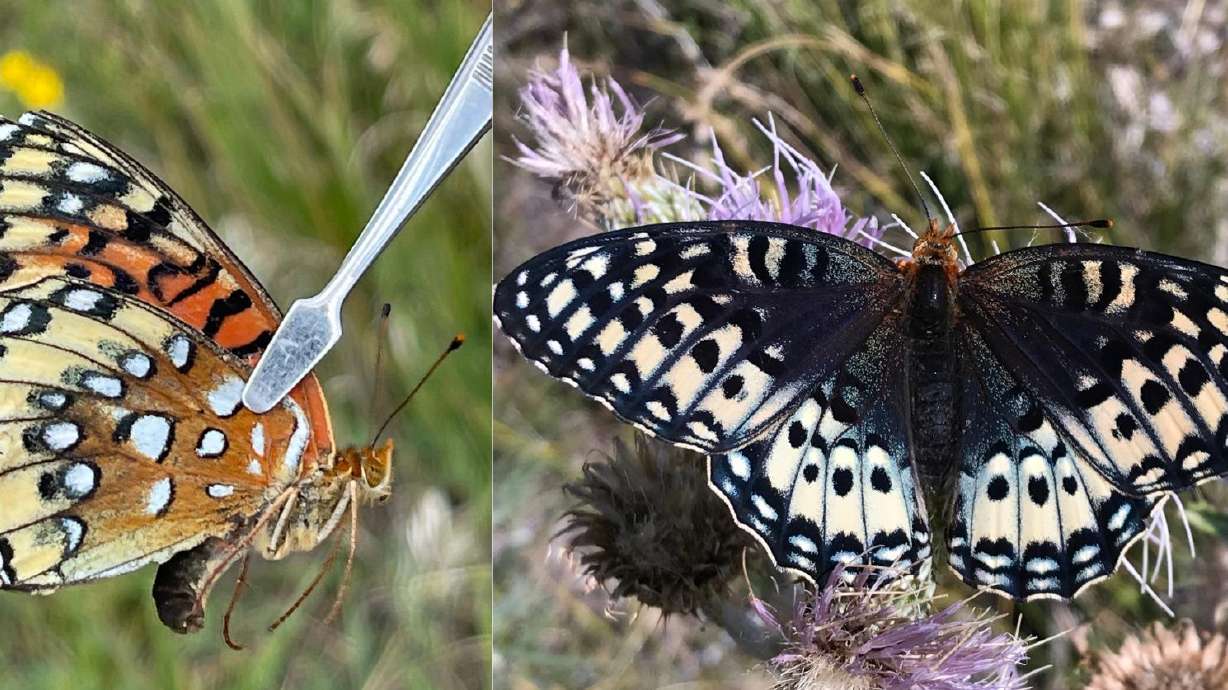Estimated read time: 4-5 minutes
This archived news story is available only for your personal, non-commercial use. Information in the story may be outdated or superseded by additional information. Reading or replaying the story in its archived form does not constitute a republication of the story.
SALT LAKE CITY — A rare butterfly found in Utah and neighboring states will land on the U.S. list of "threatened" species under the Endangered Species Act next month.
The subspecies of the silverspot butterfly, or Nokomis fritillary, named for its silver-white spots on the undersides of its wings, calls eastern Utah, northern New Mexico and southwestern Colorado its home. The subspecies, Speyeria nokomis nokomis, lives in elevations ranging from 5,200 to 8,300 feet, according to federal wildlife managers.
"While the silverspot butterfly is not in immediate danger of extinction, the best available scientific information indicates that it is likely in danger of extinction in the foreseeable future," the Department of the Interior's Fish and Wildlife Service said in a statement announcing the designation that takes effect March 18.
Why the butterfly needs protection
Amanda Barth, Rare Insect Conservation Project leader at Utah State University's Quinney College of Natural Resources, noted the petition to list the subspecies as threatened was submitted to the Fish and Wildlife Service more than 10 years ago "and the circumstances facing the butterfly's habitat have only gotten worse."
"Functionally, a listing is the last resort, or safety net, for species conservation in the absence of other conservation actions (and there have been nearly none). A recovery plan with a future de-listing is the ideal path forward from here," she said.
She said she believes the federal agency made the correct decision "based on the population trends, distribution and threats facing the silverspot."
The Rare Insect Conservation Program worked with federal agencies to evaluate the butterfly's habitat locations and quality in Utah, Barth said, and will continue to work to determine habitat restoration opportunities and monitoring.
Most of the silverspot butterflies live on private land, according to Barth.
"It's important to protect this subspecies for many reasons: It contributes to preserving species diversity and richness of our smallest wildlife; these butterflies are pollinators of nectar-rich plants that support many other pollinators, and their caterpillars are part of the food base for very small predators like fireflies which are also at-risk," Barth said.
She called the butterfly's disappearance "the result of disappearing and degraded habitat and land use practices that are not sustainable, and these fritillaries are serving as an indicator of that declining ecosystem health."
Barth said the butterfly is Utah's first insect listed as threatened, "but it is important to take action to protect other at-risk insect species because additional species listings are possible in the future."
The butterfly had already been included in a list of species of greatest conservation need for Utah since 2011, Barth said, marking it as a "conservation priority" for Utah wildlife managers.
About the silverspot butterfly
Recent surveys found 21 colonies of the butterfly grouped into 10 populations, which the Fish and Wildlife Service says is an increase from 19 colonies observed in May 2022. The subspecies of silverspot butterflies live in just 714 acres of habitat overall in the Four Corners area.
The silver-and-black or brown butterfly boasts a 3-inch wingspan, wildlife officials say. Males of the subspecies have bright orange on the upper side of their wings, and females have cream or light yellow. The butterfly lives in "moist, open meadows" and shelters in vegetation. Its nectar sources are herbaceous plants. The butterflies lay their eggs on bog violet and larvae feeds on it, and then eggs hatch in September, about two weeks after being laid, according to wildlife officials. The larvae feed on the bog violets' flowers in May through July, and they then turn into butterflies and live for about 45 days until they lay their eggs.
"Threats facing the silverspot butterfly include future effects from climate change in combination with habitat loss and fragmentation, incompatible livestock grazing, human alteration of natural hydrology, and genetic isolation. The service is not designating critical habitat for this species due to the increased threat of collection and trade for rare butterflies," according to the statement.
Shiran Hershcovich, a lepidopterist with the Butterfly Pavilion in Denver, told ABC News that the butterfly species faces a "cocktail of pressures" leading to its dwindling numbers.
Hershcovich told the outlet that golf courses and residential neighborhoods in Durango, Colorado, along the New Mexico border may have disrupted the subspecies' habitat. They feed exclusively on one plant, she said.
"So instead of having a huge region to forage on and travel, butterflies are now condensed in one very small zone," Hershcovich told ABC News. "It's going to be much harder for you to complete any sort of meaningful journey."
While the butterfly is getting federal protection, the government is not designating critical habitats for the butterfly. A critical habitat designation means the federal government can't participate in activities in an area deemed essential for the species' survival that may lead to a species' extinction. It does not affect private landowners.
The rule for the silverspot butterfly will continue to allow incidental take (meaning unintentional destruction of the butterfly) from activities "done in a manner compatible with conserving" the butterfly and the bog violet essential to its survival. Those activities include livestock grazing, haying or mowing, prescribed burning, brush control, noxious weed control, fence or structural maintenance, and maintenance to existing utility transmission corridors.










